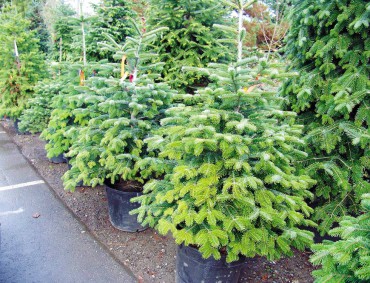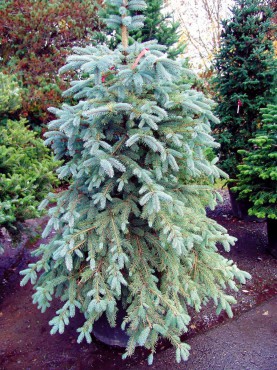
Rooflines outlined with fairy lights, porches festooned with pine and cedar garlands, and holly bushes brightly displaying their red winter berries remind us the holidays are fast approaching. Nothing says “Christmas” like a beautiful pine or fir tree, laden with shiny glass balls, lights and family mementos, welcoming family and friends for the most festive season of the year.
As costs rise and we all start trying to economize, we look at ways to minimize waste and get best value for our money. One way to save money, eliminate waste and add value to our home landscape is to consider a living Christmas tree, roots intact. Not only can a living tree solve the annual problem of finding a tree, but it will also bring many years of enjoyment while growing on the property, perhaps replacing trees recently lost to wind or pests. For nearly the same price as a tall-cut noble fir, you can purchase a native pine, spruce or fir.
Before shopping for a living tree, decide where it will be displayed inside, and where it will be planted outside. Take into account the mature size of the tree, allowing plenty of room for spreading, and the availability of water. Trees are sensitive to moisture, and some require large amounts of water; others will not thrive if their roots are too wet. If possible, choose a tree that is native to this area, as it likely will be more pest-resistant and require less long-term care than an exotic specimen tree. If space for planting outdoors isn’t a possibility, consider a slow-growing specimen for container growing on the deck or patio. A container tree can be brought in and enjoyed for years to come.

When shopping for a living tree, be aware the nursery industry markets two different types: the sheared, perfectly shaped tapered trees grown for ornamental use, and landscape-grade trees that receive little special attention. Landscape trees tend to be less expensive than the sheared variety, but might be a little rangy and less perfectly shaped.
A discussion with an experienced nursery person will reveal the ideal growing conditions for your living tree, but a little research prior to the visit is helpful. Choose an evergreen suited to personal taste in Christmas trees, but one that also fits our Western Washington climate zone.
Trees are grown under different conditions, and handle transplanting and repotting with varying degrees of success. Observe whether the tree you are selecting is growing in a container, or if the roots have been “balled and burlapped.” As a general rule, a container-grown tree will withstand repotting for years to come if handled properly, and one that is field-grown, indicated by the root ball wrapped in burlap, will be happiest planted in the ground after the holidays.
Purchase a tree from a reliable nursery source, and check to make sure the root ball is intact and has been well cared for. Condition the live tree prior to bringing indoors by storing it in a cold garage, shed, or under the patio roof for a week or so. Place the root ball in a large pot or bucket with good drainage and keep roots evenly moist while indoors. Try to place the tree away from sunny windows and heater vents. It’s best to limit the inside stay of a living tree to 10 days or less. Check the root ball every other day and water when the top 2 or 3 inches of soil is dry.
Fir trees are the most traditional type used for Christmas trees, and they are also well-suited to life in a container, as they are slow-growing and keep their shape year after year. Our native Subalpine fir (Abies lasiocarpa) sports beautiful gray bark and well-formed, blue-green needles. With a little care, Abies lasiocarpa will adapt well to serving as a living Christmas tree for many years.
The ubiquitous Douglas fir (Pseudotsuga menziesii) is seen so commonly in the West Sound area, many gardeners consider it to be a weed, but it is this very quality that makes it an excellent choice for a living Christmas tree. Because “Doug firs” are so common, they are readily available and inexpensively priced, and are often available in a sheared form. They work well as a single large specimen, or for special effects, placed in a cluster of three trees of varying heights. Douglas firs also are good porch trees just dressed in fairy lights. When planted in the yard, they are fast-growing and unfussy about light, only require well-drained soil, and need no water other than rain, once established.
Perhaps the most commonly known spruce tree is the Colorado blue spruce, Picea pungens “Glauca,” which decorates beautifully, but there are other equally beautiful choices in this group. Check your local nursery for availability and recommendations, enjoying the process of learning about the wide variety of beautiful evergreens that will thrive in our temperate Northwest climate.
Once the holidays have passed, place the tree outside in a sheltered spot, such as under a porch roof or on the south side of the house, where the root ball won’t freeze, and water as needed. The tree should be fully acclimated in about 10 days. Prepare the planting hole, which should be slightly deeper than the root ball, and twice as wide. Carefully remove the tree from the container, loosen the roots if necessary, and spread them into the hole, filling in soft soil. Mix in about 1/3 compost with 2/3 soil and tamp lightly, leaving a shallow well as wide as the drip line. Fill the well with water and let seep into the root zone. As the soil settles, add more, but leave a shallow well to collect winter moisture, and layer in about 3-4 inches of mulch to help hold in moisture and discourage weeds.
Since most conifers are relatively slow-growing, it is possible to grow the tree in a container and bring it indoors for several years. Container-grown trees must be watered year-round, when the top 2 inches of soil is dry. To prevent salt buildup, add water until it trickles out of the drain holes. Before new growth begins in the spring, gently tug the root ball out of the container and check the roots. If the roots are starting to circle the inside of the container, nip them back with sharp pruning shears, rough up the root ball, and plant in a larger pot with fresh soil. To prevent the roots from overheating in the summer, always remove the tree from the black plastic nursery pot, and plant in a ceramic pot or wooden planter. Overheated soil will kill the roots, and eventually the tree.

























Comments